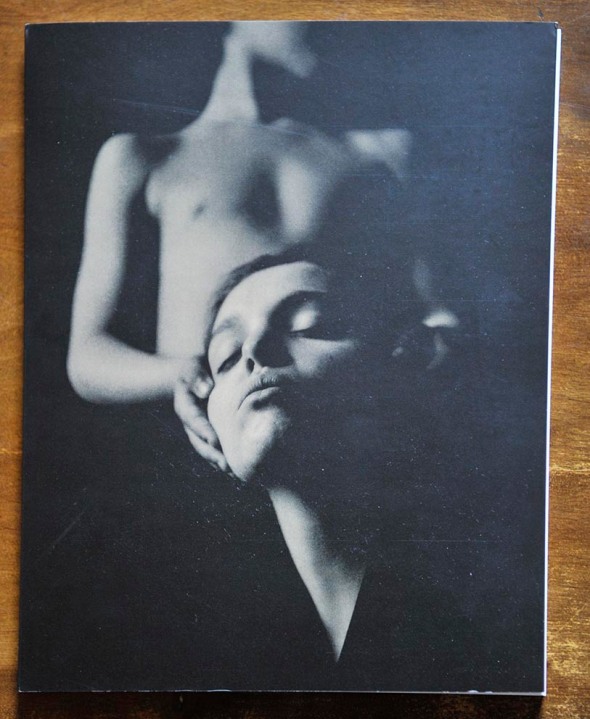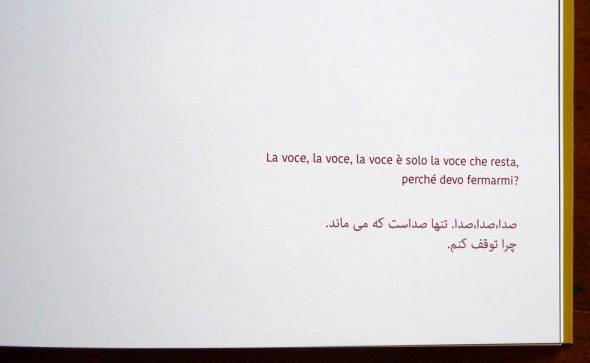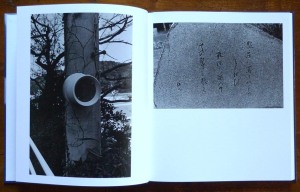She looks into me, by Nuno Moreira
Posted: February 11, 2018 Filed under: Photobooks, Photography | Tags: Adolfo Luxuria Canibal, Nuno Moreira, Paul Eluard, Poetry, Portugese photography, She looks into me, Surrealism Leave a comment
In Zona, his previous book, Nuno Moreira explored the limit of the dream and the unconscious. Using the same techniques of staging and scenography, he has published, early this year, this new opus, much more accomplished and which now clearly claims its surrealist filiation, including the title borrowed from a poem by Paul Eluard: She looks into me, which opens the book.
In his previous work, it seems that Nuno sought to « capture » his moments of unconsciousness, whereas in the realization of She looks into me, he appropriated the unconscious to strive to represent it, and his work is now much closer to that of the Surrealists. Life, death, dreams, thoughts, are the raw material. The threads are woven into a play. The pictures are always aesthetic, but it is to make us forget their presence and allow us to focus on the narration which remains interpreted by everyone’s mind. It draws, one after the other, the « being », the « becoming » and the process of deconstruction that follows (« unbecoming »). Consistency remains throughout the book, with recurring patterns that allow us to read a continuum, such as the cycle of life and death, which are, of course, ubiquitous motifs throughout the book. The rhythms change, accelerate and then slow down, before accelerating again. In this book, all the formal elements that constitute it (photos, layout, texts …) disappear at the service of the storytelling.
And finally, the title refers us to the perception that Nuno Moreira proposes to us. It is no longer a question of looking at things, but rather of looking into things, in the sense of the original French title of the poem, Elle se penche sur moi, which speaks of being available to understand the other, to find a confidence in him/her. Where it is about seeing in the other to put his life/love in his/her hands, proof of ultimate confidence, beyond life and death. Then one reads there love, the only one capable of transcending the physical limit of the body, of time, of the wear and tear that reappears in the third part of the book. Death approaches, and one then questions oneself about existence, his own and that of the other, whom we build a relation with.
The book is beautifully printed with black and white tones incredibly rich. The open spine allows a clear reading of the photos. A booklet with a text in Portugese and in English by Adolfo Luxuria Canibal, Portugese musician and poet accompanies the softcover book. Limited edition of 200 copies, 22 x 28 cm, 84 pages with 42 B&W photos. Foreword by M. F. Sullivan and afterword by Jesse Freeman.
More info : http://nmdesign.org/
The never ending story of Sheherazade : Iran seen by two photographers
Posted: July 24, 2016 Filed under: Photobooks, Photography | Tags: Behbahani, Davide Palmisano, Farrokhzad, Iran, Italian phootgraphy, Manuela Marchetti, Persia, photobooks, Poetry, Sheherazade, Sokuk, Timeless Persia Leave a commentIran (former Persia) is a fascinating country, known to be the cradle of civilization; the country went through the twentieth century by first, having one of the most dynamic intellectual society, and then, since 1979, a closed and authoritarian religious society. Very slowly, the country opens again, offering us the opportunity to rediscover it.

Davide Palmisano and Manuela Marchetti offer us a song for two voices. Two photographers who travel Iran in 2015 and who deliver their vision of the country. Each of their books is written in the thickness of time. Together, they revisit the history of Persia.
Davide’s book is entitled « Timeless Persia » and, following his traces, we discover Iran as a palimpsest. He looks at the successive layers that have shaped the country. He stops on materials, on networks that accumulate and become entangled. We discover a country on the move, a country that never stops. It is built and rebuilt continuously, keeping the scars of the past. It rubs constantly to the past and it becomes difficult to date the photographs, archival images come mix with contemporary views. We keep this feeling that everything has always been where it should be: a kind of cultural resilience, a resilience of shapes.
One begins to dream of Scheherazade, each page is a snippet of a tale that holds us in suspense until the next page. Large black-and-white photos on double pages take us across the country, they chant the rhythm. This is a slow time between the faster sequences, the time of the passing with the feeling of these landscapes already known. The book is completed with texts that remain ununderstandable to me, as written in Italian and Farsi, but that is part of the « journey », these unknown sounds, like the multitude of signs that are piling up on some images which we pictorially read. We are captives and when the book ends, we have to start it again… and again.
Manuela’s book is entitled « Sokut » meaning « silence », in Farsi. As « Timeless Persia » was noisy, or to better say sonorous with a design that varied rhythms as a traditional song, as « Sokut » is silent like these harmonics that we do not hear but create depth in melodies. Time seems to have stopped and we discover a long poem. We stop on details, private moments and places that each image slowly inscribed in us. Frames are tightened, we are looking our way in a quiet place. The persons are faceless, the only faces we see are only representations (photos, paintings, statues…). We wander anonymously in the town, a quiet town, soothed. No matter that we no longer find our way, we loose ourselves with relish, looking for freshness or a moment in the shade, to settle in calm.
Texts come punctuate the book, alternating with images. These are poems of two of the greatest Iranian poetess: Simin Behbahani and Forugh Farrokhzad. Two women who have their whole lives claimed women’s voices. And the book ends with an excerpt from « It is only sound that remains », the voice of women finally out of the silence, full of sorrows but also of hope. In that way, this book is decidedly feminist, it is a tribute to all those women who have built the country in silence.


I’ve never really asked myself about the difference between male or female representation through the use of photography, but it is so clearly evident here with these two books. Maybe it is partially due to the fact that we are focusing on a society that is cleaved between men and women. But anyway, the combination of the two works is very interesting, Manuela and Davide evolve within a country, they can work side by side but look at things differently, tell words (or silence) differently. Although claimed as two separate and independent works, it remains true that there is a real added value to associate them to better succumb to the charm of Sheherazade and be guided in this tale of the « Thousand and One Nights ».
Timeless Persia, by Davide Palmisano. Softcover self published in 2016, 16,5 x 24 cm, 76 photos , 96 pages. Limited print run : 150 copies signed and numbered.
More info : http://dpalmisano.jimdo.com/books/
And : http://josefchladek.com/book/davide_palmisano_-_timeless_persia
Sokut, by Manuela Marchetti. Softcover self published in 2016, 21,5 x 15 cm, 35 photos, 96 pages. Limited print run : 150 copies signed and numbered.
More info : http://manuelamarchetti.jimdo.com/books/
And : http://josefchladek.com/book/manuela_marchetti_-_sokut
The day « she » was planted in the garden, by Yahya Dehghanpour
Posted: September 20, 2015 Filed under: Photobooks, Photography | Tags: Forugh Farrokhzad, Garden, Iran, Iranian photography, Leprosy, photobooks, Photography, Poetry, Silk Road, Tehran, Women, Yahya Dehghanpour Leave a commentForugh Farrokhzad was one of the most renowned Persian contemporary artist. Famous for her poetry, in a conservative male society, she fought all her life for the emancipation of women, matter always to the heart of her work. She had hard times, especially after her divorce when she was disallowed the right to custody of her son. Her poetry is fulfilled with her own loneliness and her difficulties to find a serene place in Iran of the 50’s and 60’s. She has also been widely acclaimed for her wonderful documentary film, in 1963, about a leprosy colony : « The house is black ». Forugh Farrokhzad died prematurely in a car accident in 1967, at the age of 32.
The title of the book refers to her conception of « garden » which is often present in her poems amongst which, a beautiful one titled « Rebellion », about the predominance of men in the Tehran society, ending with the verses :
Come forth and release me
to the clear, pristine heights of poetry
should you allow me this flight
my rose will adorn the garden of poetry.
The metaphor of her death is her access to freedom and now, « she » was planted to adorn the garden of poetry.
On the other side, Yahya Dehghanpour, a young photographer in 1967, already involved in the cultural life of Tehran. He will leave Iran a few years later to study photography at the San Francisco Art Institute during the 70’s and will come back in Iran where he will teach photography in various Universities, and influence numerous generations of Iranian photographers. He appears to be a major figure of Iranian photography, even if it is almost impossible to find any information about him. One of the only references is an exhibition of the series from this book, at the Silk Road Art Gallery in Tehran in 2009.
So this book is made of an early work rediscovered recently by its author. A series made at a time when the death of Forugh Farrokhzad was a tragedy for the cultural society of Tehran, and when Yahya Dehghanpour, 25 years old, decided to document the funeral. The book shows the funeral ceremony, and the sequencing seems to show a complete series which build a particular atmosphere with various moments of tension. We follow the body through the city with emotion, a white hearse, flowers and people coming from everywhere. We are in the crowd, to share grief and sadness. Our sight becomes blurry and so are some photographs, which emphasize the dark and sad ambiance. All photographs are square with white margins, one per page with some alternating white pages, and there are three main chapters, each one introduced by a double page detail of a photo. The first part is the funeral procession in town, the second one is the arrival of the body at the cemetery and the third part is the burial and people around the grave.
The book comes with a small accordion booklet which is the reproduction of an installation of large prints in order to identify people who wrote their names by hand in the margin. This piece of work becomes a wonderful documentation with the entire intellectual elite from Tehran, who came to pay their last tribute!
Hardcover book, 23 x 23,5 cm, with a very sober and elegant black cover with a negative white square, and the title, the date and the name of the photographer. 95 pages with 57 black and white photos. Persian and English text by Mehran Mohajer.
Publisher site : https://www.facebook.com/ManooshPublication
Another very good review of the book : https://collectordaily.com/yahya-dehghanpour-the-day-she-was-planted-in-the-garden/
And just for pleasure her film « The house is black »
Poet Island, by Atsushi Fujiwara
Posted: April 12, 2015 Filed under: Photobooks, Photography | Tags: Akashi Kaijin, Atsushi Fujiwara, japanese photography, Japanese poetry, Nagashima Island, photobooks, Photography, Poetry 1 CommentPoetry can drive us far beyond our own perceptions. It can reveal the unknown or, to better say, the unperceived. At a very intimate level, it just tells the truth… or not, because poetry can’t lie. It has to deal with personal feelings which can only be considered as real, even if you happen to fall in a total disarray; your feelings will remain real.
As far as I can remember, I had problem with literature courses, I could simply not stand a teacher who gave an official interpretation of a text, killing any possibilities of a personal divagation. But time has passed and things have changed.
Well, once again, I started to digress, and it does not look like a photobook review, but in fact, what I wrote here above is the perfect explanation of my fascination for Atsushi Fujiwara new book : Poet Island.
With a complete humility, Atsushi takes us to visit Nagashima Island where is located the Nagashima Aiseien Sanatorium. I have first to say that it meant nothing to me before I read the book, but was revealed a strong interest for the story because Atsushi knows how to introduce a story. The Island hosted a leprosarium where the famous Japanese pre-war poet Akashi Kaijin was held in confinement. Well, to be honest I never heard of him before I discover this book, and I don’t know him better know, because it remains impossible to find any translation of his work. And this is why I like so much that book.
As a boy, Atsushi visited his uncle who worked on the Island, and he kept an abstruse image of the place mixing « its natural untouched beauty and the anguish he felt at the sad fate of the patients ». He went back thirty five years later as a photographer and came across a poem :
Like luminescent fish dwelling in the darkness of the deep sea,
There is no light until I alight from within – Akashi Kaijin
And from that, Atsushi walks on the traces of the poet. He tracks all those « in between » moments that are the thickness of life. The place is not anymore in function nowadays and we visit the island accompanied by the ghost of the poet. We walk through the places he has been, we focus on details or stop and stare at the sea. Everything and every gesture has already been done before and that’s exactly what we feel, even if the landscape has changed to a more contemporary shape. From a cell door to an open landscape, we imagine what the poet could have in mind when he wrote the lines above. Some old words or sentences on a wall and a few old personal photographs of the poet and his family. No captions, we have to assume this is not documentary but just a personal recording of the place. Another photographer would have focused on different things and places and this is what makes this book so beautiful. It is like sitting beside Atsushi while he read us some poems he likes ; this is how he introduces us to Akashi Kaijin’s world.
I haven’t said so much about the photographs. As usual with Atsushi Fujiwara, we discover some beautiful black and white pictures with sophisticated shades of grey and perfectly framed and composed. There are no coïncidences in these photos ; by the light or the shades of grey, we can feel the thickness of the time which has imprint itself on the buildings, in the ground or even on the objects, since about eighty years.
This book reminds me two excellent works with a strong connection with the Poet Island. The first one is the wonderful film by Iranian poetess and film maker Forough Farrokhzad : « La maison est noire » (the house is black) realized in 1963 about the daily life in a leprosarium in Iran, filmed in black and white and with a strong empathy for the residents, to change ugliness into compassion.
The second one is the work of a French photographer Jacqueline Salmon in 2004. The book is called « Rimbaud parti », published by Marval in 2006 with a text by Jean-Christophe Bailly. This was a commission work for the 150th commemoration of Arthur Rimbaud’s birth, and what we discover here are the landscapes of the place where Rimbaud came from (around the familial farm) and that supposedly shaped his work as a poet.
Poet Island, hardcover book, published in 2015 by Sokyusha. 24 x 28 cm, 72 pages, 61 black and white photos.
More info about Atsushi Fujiwara : http://atsushifujiwara.com/
And the gallery in)(between in Paris : http://www.inbetweengallery.com/
Some thoughts in Spanish with Gabriela’s blog : https://gabrielacendoya.wordpress.com/2015/04/09/9-de-abril-2015/











































































